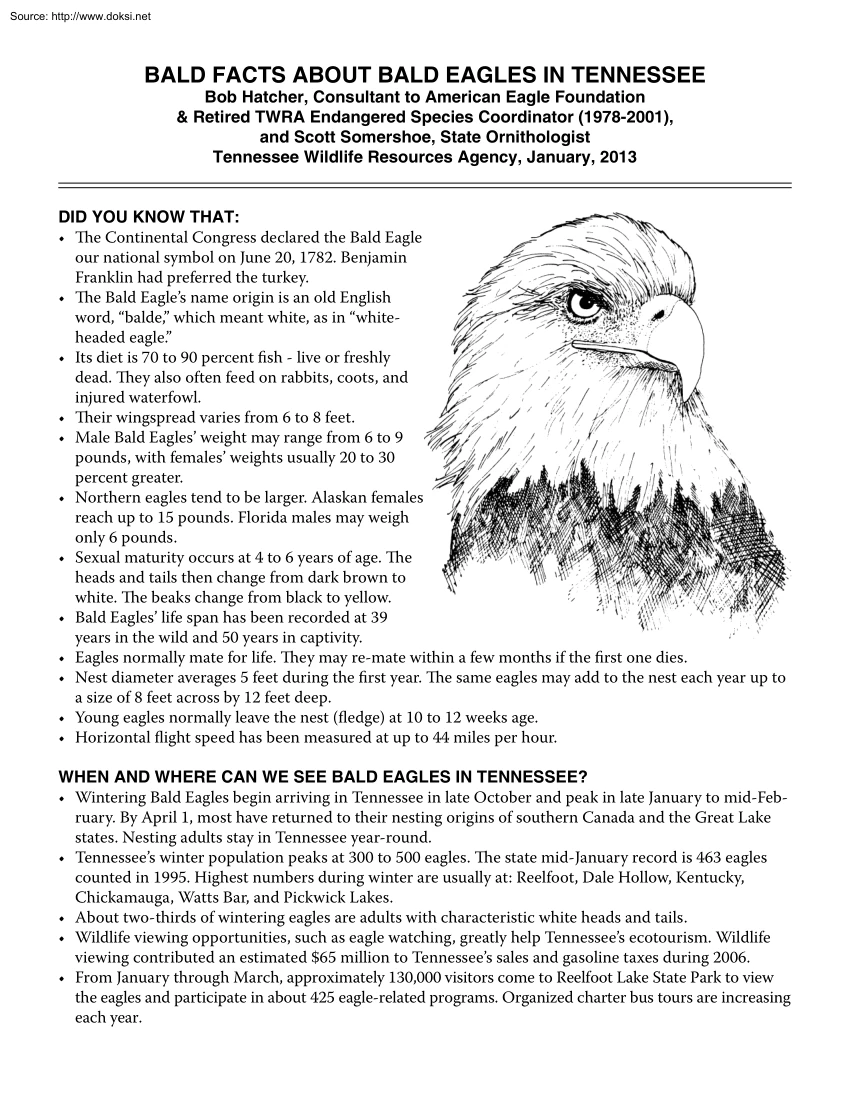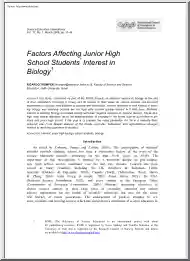A doksi online olvasásához kérlek jelentkezz be!

A doksi online olvasásához kérlek jelentkezz be!
Nincs még értékelés. Legyél Te az első!
Mit olvastak a többiek, ha ezzel végeztek?
Tartalmi kivonat
Source: http://www.doksinet BALD FACTS ABOUT BALD EAGLES IN TENNESSEE Bob Hatcher, Consultant to American Eagle Foundation & Retired TWRA Endangered Species Coordinator (1978-2001), and Scott Somershoe, State Ornithologist Tennessee Wildlife Resources Agency, January, 2013 DID YOU KNOW THAT: • The Continental Congress declared the Bald Eagle our national symbol on June 20, 1782. Benjamin Franklin had preferred the turkey. • The Bald Eagle’s name origin is an old English word, “balde,” which meant white, as in “whiteheaded eagle.” • Its diet is 70 to 90 percent fish - live or freshly dead. They also often feed on rabbits, coots, and injured waterfowl. • Their wingspread varies from 6 to 8 feet. • Male Bald Eagles’ weight may range from 6 to 9 pounds, with females’ weights usually 20 to 30 percent greater. • Northern eagles tend to be larger. Alaskan females reach up to 15 pounds. Florida males may weigh only 6 pounds. • Sexual maturity occurs at 4 to 6
years of age. The heads and tails then change from dark brown to white. The beaks change from black to yellow • Bald Eagles’ life span has been recorded at 39 years in the wild and 50 years in captivity. • Eagles normally mate for life. They may re-mate within a few months if the first one dies • Nest diameter averages 5 feet during the first year. The same eagles may add to the nest each year up to a size of 8 feet across by 12 feet deep. • Young eagles normally leave the nest (fledge) at 10 to 12 weeks age. • Horizontal flight speed has been measured at up to 44 miles per hour. WHEN AND WHERE CAN WE SEE BALD EAGLES IN TENNESSEE? • Wintering Bald Eagles begin arriving in Tennessee in late October and peak in late January to mid-February. By April 1, most have returned to their nesting origins of southern Canada and the Great Lake states. Nesting adults stay in Tennessee year-round • Tennessee’s winter population peaks at 300 to 500 eagles. The state mid-January
record is 463 eagles counted in 1995. Highest numbers during winter are usually at: Reelfoot, Dale Hollow, Kentucky, Chickamauga, Watts Bar, and Pickwick Lakes. • About two-thirds of wintering eagles are adults with characteristic white heads and tails. • Wildlife viewing opportunities, such as eagle watching, greatly help Tennessee’s ecotourism. Wildlife viewing contributed an estimated $65 million to Tennessee’s sales and gasoline taxes during 2006. • From January through March, approximately 130,000 visitors come to Reelfoot Lake State Park to view the eagles and participate in about 425 eagle-related programs. Organized charter bus tours are increasing each year. Source: http://www.doksinet • The eagles of Reelfoot Lake keep the park and several businesses open during the winter. One Reelfoot restaurant/motel owner has estimated that eagle watchers comprise 85 percent of his late winter trade. • Reelfoot State Park provides daily, guided bus tours of Bald Eagle
concentration during the winter months, when eagles can be found on many Tennessee lakes. Call 1-800-250-8617 (toll-free) for information and/or reservations • The Corps of Engineers conducts an open barge tour of Dale Hollow Lake on the third and fourth Saturdays in January. The tour is free, but advance reservations are required, beginning in mid-November, by calling 931-243-3136, or by sending e-mail to ChiefPublic-Affairs@lrn02usacearmymil More information about winter eagle viewing can be found at www.eaglesorg/festivals eventshtml WHY DID EAGLE NESTING DISAPPEAR FOR 22 YEARS IN TENNESSEE? • The insecticide, DDT, caused most of the eagle declines from the mid-50s to the mid-70s. Eggs became either infertile, or their thin shells would break under the weight of the adults. • There were 14 “active” nests at Reelfoot Lake in both 1954 and 1955. However, Tennessee had no known successful eagle nests from 1961 until 1983. • Eagles often nest on dead portions of relatively
large trees, where they have better aerial access for their wide wingspan. • Such large trees are usually on high ground within sight of lakes or rivers. They may be one or more miles inland for greater seclusion. • In order to avoid causing eagles to abandon their nests, we normally need to stay out of sight of their nests, except for routine farming, vehicular traffic, etc. Eagles are much less disturbed by manned vehicles or boats than by walkers • Due to the creation of over 530,000 acres of large reservoirs in Tennessee, we may have more potential Bald Eagle habitat than ever before. • Due largely to the banning of DDT in the U.S in 1972 and restoration efforts since 1976, nests in the lower 48 states have increased from about 800 in 1974 to over 12,000 in 2009. HOW “HACKING” HELPED RESTORE BALD EAGLES IN TENNESSEE • Almost everyone appreciates the Bald Eagle. Many people are working together to restore our national symbol in Tennessee, and across America. • By a
method known as “hacking,” eaglets approximately 8 weeks old are placed in artificial nests in Tennessee. They are released when they are about 12 to 13 weeks old, when their first flight is assured • Eagles tend to return to nest within approximately 75 miles of their maiden flights–at an average of 5 years of age. • Since 1980, TWRA and its partners have coordinated the hacking of eaglets obtained from: Alaska.112 Captive-Bred.154 Wisconsin.60 Minnesota.11 Canada.2 Tennessee.3 Iowa.1 Florida.1 Total. 344 • Eaglets have been delivered for hacking in Tennessee through the courtesy of the airlines: American, Northwest, Alaskan, and Emery Worldwide. • During 1980-2012, Tennessee’s Bald Eagle hacking releases have been as follows: 80 81 82 83 84 85 86 87 88 89 90 91 92 93 94 95 96 97 98 99 00 01 02 03 04 05 06 07 08 09 10 11 12 Total 2 344 6 4 5 10 11 16 22 19 20 31 37 34 13 15 8 11 5 5 6 4 0 3 2 5 6 2 10 10 4 4 7 7 Source: http://www.doksinet •
Young Bald Eagles were released from seven Tennessee hack sites since 1980: Hack Site Years Eagles Cooperators Land Between the Lakes 1980-88 44 TVA, Tennessee Wildlife Federation (TWF), TWRA Reelfoot Lake (NW TN) 1981-88 43 TWRA, TN Ornithological Society (TOS), Wildlife Preservation Corps (WPC), Miller Brewing Co. Dale Hollow Lake 1987-91 44 US Army Corps of Engineers (USACE), Tennessee Technological University (TTU), TWRA Chickamauga Lake (SE Tenn) 1989-92 43 TWRA, TOS, Exxon, American Eagle Foundation (AEF), T. Pride, Ed Averitt, Olin Corp Scottsboro (Cheatham Lake, TN) 1990-92 22 TWRA, AEF, Exxon, Bell Construction, Bill Coble, LifeWorks Foundation South Holston Lake (E. of Bristol) 1991-94 29 US Forest Service, TTU, TWRA, Bristol Herald-Courier, Public Douglas Lake (S. of Dandridge) 1992-12 119 AEF, Dollywood, TWRA Total 344 • Since 1981, over 65 volunteers from the Tennessee Ornithological Society (TOS) and the American Eagle Foundation
(AEF) have helped TWRA hack eagles at the above sites. • Eagle hacking will continue at Douglas Lake as feasible for the sponsors, AEF and Dollywood. Bald Eagle hacking has been completed at all other Tennessee sites. • AEF also rehabilitates injured eagles and captive breeds them at Dollywood for hacking in Tennessee. • During 1995-2006, 47 Golden Eagles were released at two hack sites, as shown below. This includes 37 Golden Eagles during 1995-2000 on Chickamauga Lake, a former Bald Eagle hack site. Two anonymous Chattanooga donors fully funded the project during 1998-2000. During 2001-06, AEF released 10 more Golden Eagles on Douglas Lake at an existing Bald Eagle hack site. Golden Eagle hacking has been discontinued in Tennessee Year 1995 1996 1997 1998 1999 2000 2001 2002 2003 2004 2005 2006 Total Hack Site Chic Lake Chic Chic Chic Chic Chic Doug Lk Doug Doug Doug Doug Doug -- Source Mont. Zoo AEF AEF Wyo Wyo Wyo AEF AEF AEF AEF AEF
AEF -- 1 2 1 11 10 12 2 2 2 1 1 2 47 Golden Eagles WHAT PROGRESS IS BEING MADE WITH EAGLE NESTING IN TENNESSEE? • When one bald eaglet was hatched near Dover in 1983, it was the first known successful Bald Eagle nest in Tennessee in 22 years. • Tennessee’s eagle hacking has undoubtably helped Bald Eagle nesting recovery in other states. For example, in 2000, 19 of Kentucky’s 23 occupied territories were successful at fledging at least 32 young All nests were within 75 miles of Tennessee’s various hack sites, whereas Kentucky has had no eagle release program. • Successful nests increased from 24 in 1998 to at least 125 in 2012. Fledged young increased from 46 in 1998 to an estimated 215 in 2012. • The Bald Eagle was down-listed from Endangered to Threatened in Tennessee in 1994; and in the lower 48 states in 1995. • Color markers help identify Tennessee’s hacked Bald Eagles. During 1981–1986, red plastic leg bands were used. During 1987, all hacked
Bald Eagles had left wing tags with an overall green background During 1989–2011, the left wing tags had 2-inch orange numbers inside a white oval atop a primarily green background. Source: http://www.doksinet • In 2000, TWRA down-listed the Bald Eagle from State Threatened to “In Need of Management.” It was federally delisted from Federally Threatened in 2007. • Occupied eagle nest sites are being managed in cooperation with the landowners. • Tennessee’s Bald Eagle nesting activity has increased steadily since 1983: Year 83 84 85 86 87 88 89 90 91 92 93 94 95 96 97 98 99 00 01–08 Occupied Nests 09 10 11 12 1 2 8 8 9 10 14 16 18 16 18 21 26 25 30 38 44 43 no data 130 140* 150 175 Successful Nests 1 2 2 4 5 Fledged Young 2 3 7 9 15 10 31 18 20 29 22 28 30 34 46 50 63 no data 140* 159 180 215 1 8 6 6 11 11 15 13 15 20 18 24 28 36 no data 85* 91 110 123 *Numbers of nests are estimates. HOW CAN EDUCATION HELP EAGLES? • As eagles return to
nest, we can all help them thrive if we learn more about their needs and threats. For example, if we can “enjoy eagles from a non-threatening distance,” which is at least 300 feet away, they are more likely to stay around. • AEF uses live non-releasable birds of prey to entertain and educate over 500,000 people per year at Dollywood and across the nation. • During 1996-2012, AEF has flown its non-releasable Bald Eagle, Challenger, at an annual average of 20 major events, such as several World Series and NFL football games. This and related educational programs have increased eagle awareness and support for eagles and the general environment • Country music stars are major supporters of Tennessee’s eagle program, with over 35 artists having sponsored eagles for hacking. Several others have made public service announcements on behalf of eagles • For more information about eagles and other wildlife, visit TWRA’s Watchable Wildlife website (www.tnwatchablewildifeorg)
CONCLUSIONS: • Our delisted National Symbol can be compared to a patient that has gone home from the hospital to recuperate. Its progress needs to be closely monitored for at least 20 years after delisting so that it doesn’t “return to the hospital.” • The Bald Eagle needs our continued help for achieving their potential recovery–and for enjoyment by Tennessee’s many interested citizens and visitors. • You can help by purchasing TWRA’s bluebird license plate from your County Clerk. Tennessee Wildlife Resources Agency Scott Somershoe, State Ornithologist P. O Box 40747, Nashville, TN 37204 E-mail: Scott.Somershoe@tngov TWRA website: www.tnwildlifeorg TWRA website: www.tnwildlifeorg American Eagle Foundation Bob Hatcher, Eagle Consultant and Correspondent P.O Box 333 Pigeon Forge, TN 37868 E-mail: EagleMail@eagles.org Eagle website: www.eaglesorg Tennessee Watchable Wildlife website: www.tnwatchablewildlifeorg Equal opportunity to participate in and benefit from
programs of the Tennessee Wildlife Resources Agency is available to all persons without regard to their race, color, national origin, sex, age, disability, or military service. TWRA is also an equal opportunity/equal access employer Questions should be directed to TWRA, Human Resources Office, P.O Box 40747, Nashville, TN 37204, (615) 781-6594 (TDD 781-6691), or to the US Fish and Wildlife Service, Office for Human Resources, 4401 N. Fairfax Dr, Arlington, VA 22203 Tennessee Wildlife Resources Agency Authorization No. 328726, 8,000 copies, January, 2013 This public document was promulgated at a cost of $07 per copy
years of age. The heads and tails then change from dark brown to white. The beaks change from black to yellow • Bald Eagles’ life span has been recorded at 39 years in the wild and 50 years in captivity. • Eagles normally mate for life. They may re-mate within a few months if the first one dies • Nest diameter averages 5 feet during the first year. The same eagles may add to the nest each year up to a size of 8 feet across by 12 feet deep. • Young eagles normally leave the nest (fledge) at 10 to 12 weeks age. • Horizontal flight speed has been measured at up to 44 miles per hour. WHEN AND WHERE CAN WE SEE BALD EAGLES IN TENNESSEE? • Wintering Bald Eagles begin arriving in Tennessee in late October and peak in late January to mid-February. By April 1, most have returned to their nesting origins of southern Canada and the Great Lake states. Nesting adults stay in Tennessee year-round • Tennessee’s winter population peaks at 300 to 500 eagles. The state mid-January
record is 463 eagles counted in 1995. Highest numbers during winter are usually at: Reelfoot, Dale Hollow, Kentucky, Chickamauga, Watts Bar, and Pickwick Lakes. • About two-thirds of wintering eagles are adults with characteristic white heads and tails. • Wildlife viewing opportunities, such as eagle watching, greatly help Tennessee’s ecotourism. Wildlife viewing contributed an estimated $65 million to Tennessee’s sales and gasoline taxes during 2006. • From January through March, approximately 130,000 visitors come to Reelfoot Lake State Park to view the eagles and participate in about 425 eagle-related programs. Organized charter bus tours are increasing each year. Source: http://www.doksinet • The eagles of Reelfoot Lake keep the park and several businesses open during the winter. One Reelfoot restaurant/motel owner has estimated that eagle watchers comprise 85 percent of his late winter trade. • Reelfoot State Park provides daily, guided bus tours of Bald Eagle
concentration during the winter months, when eagles can be found on many Tennessee lakes. Call 1-800-250-8617 (toll-free) for information and/or reservations • The Corps of Engineers conducts an open barge tour of Dale Hollow Lake on the third and fourth Saturdays in January. The tour is free, but advance reservations are required, beginning in mid-November, by calling 931-243-3136, or by sending e-mail to ChiefPublic-Affairs@lrn02usacearmymil More information about winter eagle viewing can be found at www.eaglesorg/festivals eventshtml WHY DID EAGLE NESTING DISAPPEAR FOR 22 YEARS IN TENNESSEE? • The insecticide, DDT, caused most of the eagle declines from the mid-50s to the mid-70s. Eggs became either infertile, or their thin shells would break under the weight of the adults. • There were 14 “active” nests at Reelfoot Lake in both 1954 and 1955. However, Tennessee had no known successful eagle nests from 1961 until 1983. • Eagles often nest on dead portions of relatively
large trees, where they have better aerial access for their wide wingspan. • Such large trees are usually on high ground within sight of lakes or rivers. They may be one or more miles inland for greater seclusion. • In order to avoid causing eagles to abandon their nests, we normally need to stay out of sight of their nests, except for routine farming, vehicular traffic, etc. Eagles are much less disturbed by manned vehicles or boats than by walkers • Due to the creation of over 530,000 acres of large reservoirs in Tennessee, we may have more potential Bald Eagle habitat than ever before. • Due largely to the banning of DDT in the U.S in 1972 and restoration efforts since 1976, nests in the lower 48 states have increased from about 800 in 1974 to over 12,000 in 2009. HOW “HACKING” HELPED RESTORE BALD EAGLES IN TENNESSEE • Almost everyone appreciates the Bald Eagle. Many people are working together to restore our national symbol in Tennessee, and across America. • By a
method known as “hacking,” eaglets approximately 8 weeks old are placed in artificial nests in Tennessee. They are released when they are about 12 to 13 weeks old, when their first flight is assured • Eagles tend to return to nest within approximately 75 miles of their maiden flights–at an average of 5 years of age. • Since 1980, TWRA and its partners have coordinated the hacking of eaglets obtained from: Alaska.112 Captive-Bred.154 Wisconsin.60 Minnesota.11 Canada.2 Tennessee.3 Iowa.1 Florida.1 Total. 344 • Eaglets have been delivered for hacking in Tennessee through the courtesy of the airlines: American, Northwest, Alaskan, and Emery Worldwide. • During 1980-2012, Tennessee’s Bald Eagle hacking releases have been as follows: 80 81 82 83 84 85 86 87 88 89 90 91 92 93 94 95 96 97 98 99 00 01 02 03 04 05 06 07 08 09 10 11 12 Total 2 344 6 4 5 10 11 16 22 19 20 31 37 34 13 15 8 11 5 5 6 4 0 3 2 5 6 2 10 10 4 4 7 7 Source: http://www.doksinet •
Young Bald Eagles were released from seven Tennessee hack sites since 1980: Hack Site Years Eagles Cooperators Land Between the Lakes 1980-88 44 TVA, Tennessee Wildlife Federation (TWF), TWRA Reelfoot Lake (NW TN) 1981-88 43 TWRA, TN Ornithological Society (TOS), Wildlife Preservation Corps (WPC), Miller Brewing Co. Dale Hollow Lake 1987-91 44 US Army Corps of Engineers (USACE), Tennessee Technological University (TTU), TWRA Chickamauga Lake (SE Tenn) 1989-92 43 TWRA, TOS, Exxon, American Eagle Foundation (AEF), T. Pride, Ed Averitt, Olin Corp Scottsboro (Cheatham Lake, TN) 1990-92 22 TWRA, AEF, Exxon, Bell Construction, Bill Coble, LifeWorks Foundation South Holston Lake (E. of Bristol) 1991-94 29 US Forest Service, TTU, TWRA, Bristol Herald-Courier, Public Douglas Lake (S. of Dandridge) 1992-12 119 AEF, Dollywood, TWRA Total 344 • Since 1981, over 65 volunteers from the Tennessee Ornithological Society (TOS) and the American Eagle Foundation
(AEF) have helped TWRA hack eagles at the above sites. • Eagle hacking will continue at Douglas Lake as feasible for the sponsors, AEF and Dollywood. Bald Eagle hacking has been completed at all other Tennessee sites. • AEF also rehabilitates injured eagles and captive breeds them at Dollywood for hacking in Tennessee. • During 1995-2006, 47 Golden Eagles were released at two hack sites, as shown below. This includes 37 Golden Eagles during 1995-2000 on Chickamauga Lake, a former Bald Eagle hack site. Two anonymous Chattanooga donors fully funded the project during 1998-2000. During 2001-06, AEF released 10 more Golden Eagles on Douglas Lake at an existing Bald Eagle hack site. Golden Eagle hacking has been discontinued in Tennessee Year 1995 1996 1997 1998 1999 2000 2001 2002 2003 2004 2005 2006 Total Hack Site Chic Lake Chic Chic Chic Chic Chic Doug Lk Doug Doug Doug Doug Doug -- Source Mont. Zoo AEF AEF Wyo Wyo Wyo AEF AEF AEF AEF AEF
AEF -- 1 2 1 11 10 12 2 2 2 1 1 2 47 Golden Eagles WHAT PROGRESS IS BEING MADE WITH EAGLE NESTING IN TENNESSEE? • When one bald eaglet was hatched near Dover in 1983, it was the first known successful Bald Eagle nest in Tennessee in 22 years. • Tennessee’s eagle hacking has undoubtably helped Bald Eagle nesting recovery in other states. For example, in 2000, 19 of Kentucky’s 23 occupied territories were successful at fledging at least 32 young All nests were within 75 miles of Tennessee’s various hack sites, whereas Kentucky has had no eagle release program. • Successful nests increased from 24 in 1998 to at least 125 in 2012. Fledged young increased from 46 in 1998 to an estimated 215 in 2012. • The Bald Eagle was down-listed from Endangered to Threatened in Tennessee in 1994; and in the lower 48 states in 1995. • Color markers help identify Tennessee’s hacked Bald Eagles. During 1981–1986, red plastic leg bands were used. During 1987, all hacked
Bald Eagles had left wing tags with an overall green background During 1989–2011, the left wing tags had 2-inch orange numbers inside a white oval atop a primarily green background. Source: http://www.doksinet • In 2000, TWRA down-listed the Bald Eagle from State Threatened to “In Need of Management.” It was federally delisted from Federally Threatened in 2007. • Occupied eagle nest sites are being managed in cooperation with the landowners. • Tennessee’s Bald Eagle nesting activity has increased steadily since 1983: Year 83 84 85 86 87 88 89 90 91 92 93 94 95 96 97 98 99 00 01–08 Occupied Nests 09 10 11 12 1 2 8 8 9 10 14 16 18 16 18 21 26 25 30 38 44 43 no data 130 140* 150 175 Successful Nests 1 2 2 4 5 Fledged Young 2 3 7 9 15 10 31 18 20 29 22 28 30 34 46 50 63 no data 140* 159 180 215 1 8 6 6 11 11 15 13 15 20 18 24 28 36 no data 85* 91 110 123 *Numbers of nests are estimates. HOW CAN EDUCATION HELP EAGLES? • As eagles return to
nest, we can all help them thrive if we learn more about their needs and threats. For example, if we can “enjoy eagles from a non-threatening distance,” which is at least 300 feet away, they are more likely to stay around. • AEF uses live non-releasable birds of prey to entertain and educate over 500,000 people per year at Dollywood and across the nation. • During 1996-2012, AEF has flown its non-releasable Bald Eagle, Challenger, at an annual average of 20 major events, such as several World Series and NFL football games. This and related educational programs have increased eagle awareness and support for eagles and the general environment • Country music stars are major supporters of Tennessee’s eagle program, with over 35 artists having sponsored eagles for hacking. Several others have made public service announcements on behalf of eagles • For more information about eagles and other wildlife, visit TWRA’s Watchable Wildlife website (www.tnwatchablewildifeorg)
CONCLUSIONS: • Our delisted National Symbol can be compared to a patient that has gone home from the hospital to recuperate. Its progress needs to be closely monitored for at least 20 years after delisting so that it doesn’t “return to the hospital.” • The Bald Eagle needs our continued help for achieving their potential recovery–and for enjoyment by Tennessee’s many interested citizens and visitors. • You can help by purchasing TWRA’s bluebird license plate from your County Clerk. Tennessee Wildlife Resources Agency Scott Somershoe, State Ornithologist P. O Box 40747, Nashville, TN 37204 E-mail: Scott.Somershoe@tngov TWRA website: www.tnwildlifeorg TWRA website: www.tnwildlifeorg American Eagle Foundation Bob Hatcher, Eagle Consultant and Correspondent P.O Box 333 Pigeon Forge, TN 37868 E-mail: EagleMail@eagles.org Eagle website: www.eaglesorg Tennessee Watchable Wildlife website: www.tnwatchablewildlifeorg Equal opportunity to participate in and benefit from
programs of the Tennessee Wildlife Resources Agency is available to all persons without regard to their race, color, national origin, sex, age, disability, or military service. TWRA is also an equal opportunity/equal access employer Questions should be directed to TWRA, Human Resources Office, P.O Box 40747, Nashville, TN 37204, (615) 781-6594 (TDD 781-6691), or to the US Fish and Wildlife Service, Office for Human Resources, 4401 N. Fairfax Dr, Arlington, VA 22203 Tennessee Wildlife Resources Agency Authorization No. 328726, 8,000 copies, January, 2013 This public document was promulgated at a cost of $07 per copy



